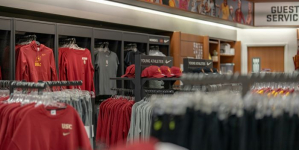-
AI startup Onton raises $7.5M to reinvent the way the world discovers and decides what to buy - November 26, 2025
-
Forklift Market Positions for Recovery as Confidence Expected to Build from 2026 - November 26, 2025
-
PROCare achieves 300% order capacity increase and 99% picking accuracy with Forterro’s ERP solution, Orderwise - November 26, 2025
-
DHL boosts operational efficiency and customer communications with HappyRobot’s AI Agents - November 25, 2025
-
STENA LINE TEAMS UP WITH CAMERA TELEMATICS TO DRIVE SAFETY IMPROVEMENTS AT IRISH SEA PORTS - November 25, 2025
-
Another design award for Toyota’s lithium-ion Traigo_i counterbalanced forklift - November 21, 2025
-
Stuut Technologies Raises $29.5 Million Series A Led by Andreessen Horowitz to Automate Accounts Receivable Work - November 20, 2025
-
INCREASED DIGITAL INVESTMENT REQUIRED TO KEEP PACE WITH 2026 CUSTOMS CHANGES - November 19, 2025
-
FULFILMENT SOLUTIONS FOR SPORTS MERCHANDISE: KEEPING OUR EYE ON THE GAME - November 19, 2025
-
COMPLEX, COSTLY & CONFUSING – THE END OF DE MINIMIS - November 19, 2025
Evaluating The Benefits Of Goods To Person Picking.
Most distribution centres (DCs) use a person-to-goods picking model whereby inventory is stored out on the floor and the most efficient pick paths are determined with the help of routing logic, typically provided by the WMS. DCs have relied on this order picking model for decades, but new models are now emerging which have challenged the traditional person-to-goods approach. This change has arisen as a result of multiple factors: growth in the number of SKUs stored in a warehouse, the demands of e-commerce and just-in-time ordering, plus increasing workforce labour costs.
Where it was once acceptable for a picker to spend 60 percent of the time traveling and 40 percent of the time picking, distribution professionals are now requiring more efficient solutions to minimise wasted time between picks and increase the number of orders processed per person. That’s why many of them are embracing a goods-to-person fulfillment approach, where operators are automatically presented with only the goods needed for their orders, using advanced technology for inventory storage and movement. When correctly applied and fully integrated with a WMS, these systems can significantly reduce miss-pick rates and improve accuracy and productivity. But how can you evaluate whether they are right for your DC environment?
Assessing the economic viability of goods to person picking
Medium and slow SKU movers are often a better candidate for goods-to-person automated systems. These are the SKUs for which the picker, in a traditional person-to-goods picking environment, will have to walk down multiple aisles between picks. Eliminating this walk time with a goods-to-person solution is where automated systems can deliver their greatest pick time and cost reduction efficiencies.
To identify whether goods to person picking is a worthwhile investment, the DC’s SKU and order activity must be closely monitored and analysed to determine how activity levels fluctuate over time, even down to the level of variation on a wave by wave basis, if necessary. Factors to be evaluated may include for example, daily unit volumes, units or lines per order, packing sequences, unit cube and cube movement, cartons per order, total SKUs and percent of SKUs in daily demand. An operational assessment might include monitoring for spikes in throughput, order cut-off times, number of fulfillment shifts, growth projections, initial capital investment, manageability, total labour costs, accuracy, product security, space and speed of processing required. After completing a detailed assessment, it will be possible to quantify the business case for an automated goods-to-person solution and potentially identify the need for a semi-automated or manual person-to-goods solution to operate in tandem.
For example, with a DC that is handling 5,000 SKUs, 90 or 95 percent of those SKUs may fit well into a highly automated goods-to-person solution. The remaining 5 or 10 percent, however, may be fast movers that will feature on fewer orders. These SKUs may be better suited to a more traditional pick methodology, such as a carton or pallet flow rack, if the order count is high enough. Such picks can be made in a relatively compact area, which reduces pick walking while achieving volume throughput. Rather than putting all SKUs into a goods-to-person automated solution, by separating out the fastest movers, less capital would be spent for automation while still maintaining very high pick rates.
Additional considerations before implementing goods to person picking
A goods-to-person pick solution should be approached from a process perspective, rather than being based on any specific automated technology. There is rarely a single solution that efficiently works across all of a DC’s SKUs and other key questions should be considered, including:
- System susceptibility to single-point system failure. For example, if one section of the system was disabled for repairs, could the system continue to operate at 100 percent functionality?
- Is the system design flexible enough to easily expand in scale as DC volumes increase? Systems should be adaptable and configurable to fit different building heights, span multiple levels and overcome obstacles in the warehouse, such as pillars or walls.
- How can the system be made energy efficient? For example, by consuming less power while maintaining excellent weight-to-payload ratios and also using energy recuperation modules to generate and store electricity from system shuttles while in operation.
Overall, whatever order picking system you consider for your DC, understand that no single system will fully meet all your requirements. Logistics professionals need to assess which characteristics are most critical to their requirements and identify the system to best meet their needs.
About the author: Mike Chadwick is a Supply Chain Consultant at WMS software specialists, Indigo Software. Visit stand 93 to discuss the best order picking strategies for your business.
www.indigo.co.uk
At a glance: Goods to person picking systems
How does goods to person picking work?
The goods-to-person concept is simple. Incoming goods are removed from pallets, either manually or automatically. The cartons and/or pieces are then placed into totes (for smaller goods) or into trays (for larger goods) and stored in high-density automated storage and retrieval systems (ASRS), carousels or robotic systems.
As orders are required to be fulfilled, SKUs are automatically retrieved from storage and brought to the picker, either at a pick station where the operator picks into an order container or to an ergonomic palletising station where items are placed on a pallet. Since the picker does not have to walk, the focus at the pick stations and pack stations is on ergonomics and high productivity.
Best Applications
- High performance goods-to-person (GTP) item picking
- Wide range of SKU profiles from slow to fast movers
- Wide range of order profiles from small .com to large retail orders
Key Benefits
- Dense secure storage which reduces building and land costs
- High productivity reduces labour costs
- A 500-1,000 picks/hour/picker
- Ergonomic picking stations ensure sustained productivity
- Picking direct to shipping containers reduces packing labour, improves inventory management and order accuracy.

































